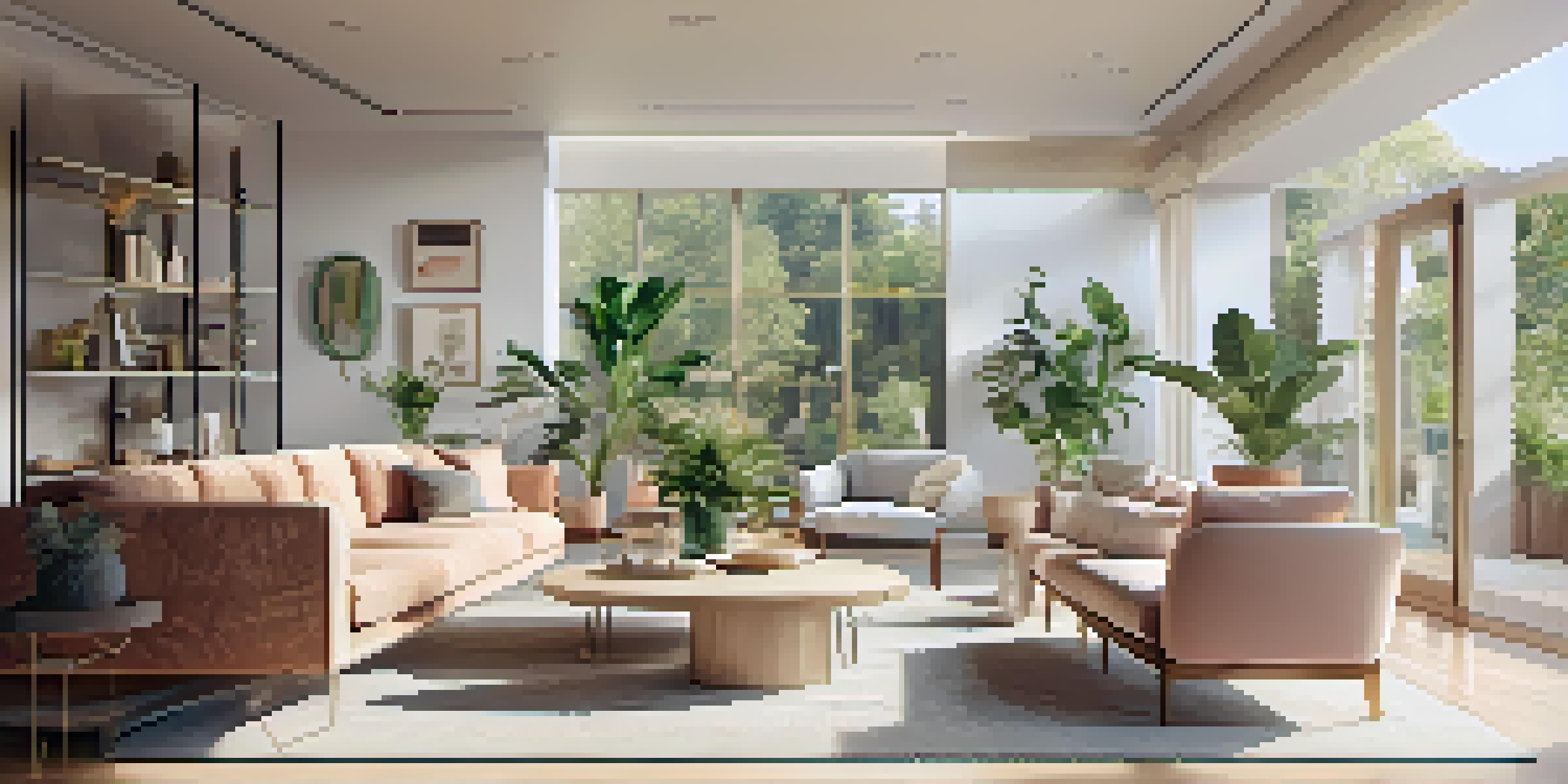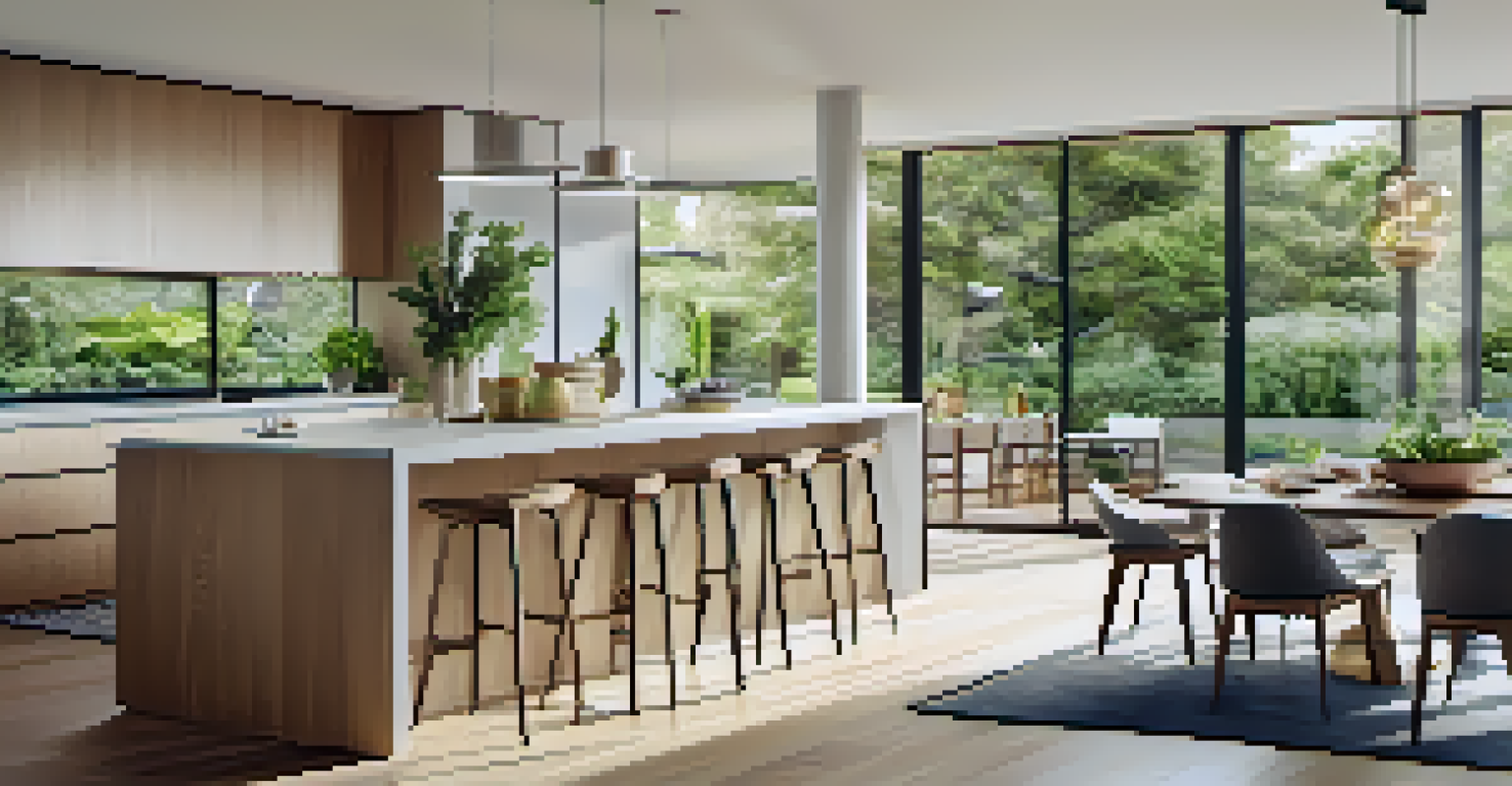Maximizing Natural Light: Strategies for Bright Interiors

Understanding the Importance of Natural Light in Interiors
Natural light not only enhances the aesthetic appeal of a space but also significantly impacts our mood and well-being. When sunlight filters through windows, it creates a warm and inviting atmosphere that artificial lighting often fails to replicate. Additionally, studies suggest that exposure to natural light can boost productivity and creativity, making it a vital element for both homes and workplaces.
Natural light is the most important ingredient in a great room.
Incorporating natural light into your interiors can also reduce energy costs, as you'll rely less on artificial lighting during the day. This eco-friendly approach aligns with the growing trend towards sustainable living, making it a win-win situation. By maximizing daylight, you not only create a vibrant space but contribute positively to the environment and your wallet.
Ultimately, understanding the benefits of natural light can inspire you to make thoughtful design choices that elevate your interiors. Whether you’re redesigning a room or simply looking to refresh your space, embracing natural light can transform your environment into a haven of comfort and liveliness.
Strategic Window Placement for Optimal Light Flow
One of the most effective ways to maximize natural light is through strategic window placement. Consider the orientation of your home; south-facing windows typically receive the most sunlight throughout the day, while north-facing windows tend to provide a softer, diffused light. By prioritizing these placements in your design, you can enhance the overall brightness of your interiors.

In addition to the orientation, the size and style of your windows play a crucial role. Larger windows or floor-to-ceiling options can dramatically increase the amount of natural light entering a room. You might also consider incorporating skylights or clerestory windows, which allow light to pour in from above, creating a spacious and airy feel.
Natural Light Enhances Well-Being
Exposure to natural light boosts mood and productivity, making it essential for vibrant living and working spaces.
Don’t forget about window treatments, as they can either block or enhance light. Opt for sheer curtains or blinds that can be easily adjusted to let in more light during the day. By thoughtfully designing your window layout, you can create a seamless flow of natural light that brightens your interiors.
Choosing Light Colors to Reflect Natural Light
The colors you choose for your walls and furnishings can significantly affect how light interacts with your space. Light, neutral colors like whites, creams, and soft pastels reflect sunlight, making a room feel brighter and more open. This simple design principle can have a profound impact on the overall ambiance of your interiors.
Light is the first element of design; without it there is no color, form, or texture.
Conversely, darker colors tend to absorb light, which can make a room feel smaller and dimmer. However, this doesn’t mean you should avoid darker hues altogether; using them as accents can create depth and contrast. Pairing darker elements with lighter walls can help maintain a balanced atmosphere while still allowing for visual interest.
Furthermore, consider the finish of your paint or materials. Matte finishes absorb more light, while glossy surfaces reflect it, enhancing brightness. By selecting the right colors and finishes, you can create a space that feels inviting and well-lit, no matter the time of day.
Incorporating Mirrors to Amplify Light
Mirrors are a brilliant tool for amplifying natural light in your interiors. When strategically placed opposite windows, mirrors can reflect sunlight, effectively doubling its impact and brightness in a room. This technique not only brightens the space but also adds depth, making the area feel larger than it actually is.
Consider using mirrors of varying sizes and shapes to create visual interest. A large, statement mirror can serve as a focal point, while smaller mirrors can be arranged in a gallery style for a unique touch. Additionally, mirrored furniture or decor pieces can subtly enhance light reflection without overwhelming the design.
Strategic Design Maximizes Light
Thoughtful window placement, color choices, and furniture selection can significantly increase the flow of natural light in your interiors.
Remember that the placement of mirrors is key; avoid placing them where they reflect clutter or dark corners. Instead, aim for reflections of beautiful views or well-lit areas to maximize the uplifting effect of natural light throughout your home.
Utilizing Open Layouts for Increased Light Flow
Open layouts have gained popularity for their ability to create airy, light-filled spaces. By minimizing walls and barriers, you allow natural light to flow freely from room to room, enhancing the overall brightness of your home. This design approach not only fosters a sense of connection between spaces but also maximizes the impact of daylight throughout the day.
Consider removing or reducing the height of walls between rooms, particularly in areas like kitchens and living rooms. This can create an inviting environment where light circulates effortlessly. Additionally, using partial dividers, such as bookshelves or decorative screens, can help define spaces without obstructing light.
It's essential to maintain a cohesive design style in an open layout. Use consistent color palettes and materials across the space to create harmony. With a well-planned open layout, you can enjoy the benefits of natural light while creating a welcoming and functional home.
Choosing Appropriate Furniture for Light Optimization
The furniture you select can either obstruct or enhance natural light in your space. Opting for lighter furniture pieces can help maintain that bright, airy feel while also reflecting light. Consider using materials like glass or acrylic, which can create the illusion of more space and allow light to pass through.
Additionally, selecting furniture with a low profile can help keep sightlines open, allowing light to flow unobstructed. For instance, low sofas or chairs can help maintain a sense of openness, while taller, bulkier pieces can create visual barriers that block light.
Incorporating Nature Brightens Spaces
Adding indoor plants and natural elements not only livens up your decor but also enhances the brightness and ambiance of your home.
Moreover, be mindful of the arrangement of your furniture. Placing larger pieces away from windows can help maximize light exposure, while strategically positioning smaller items can create a more open and inviting atmosphere. By choosing the right furniture and arranging it thoughtfully, you can create a bright and welcoming interior.
Embracing Nature: Indoor Plants and Natural Elements
Incorporating indoor plants not only brings a touch of nature indoors but also enhances the overall brightness of your space. Plants can thrive in natural light, so placing them near windows can help them flourish while adding vibrant greens to your interiors. This natural element can create a refreshing atmosphere that feels alive and inviting.
Consider using a variety of plants at different heights to create visual interest and layers in your space. Hanging plants, tall floor plants, and small table arrangements can add dimension while also maximizing the effect of natural light. Additionally, consider using light-colored pots that reflect light, further enhancing the brightness of the area.

Moreover, integrating natural materials like wood, stone, and organic textiles can complement your plants and create a cohesive, nature-inspired design. By embracing nature within your interiors, you can create a serene environment that celebrates the beauty of natural light.